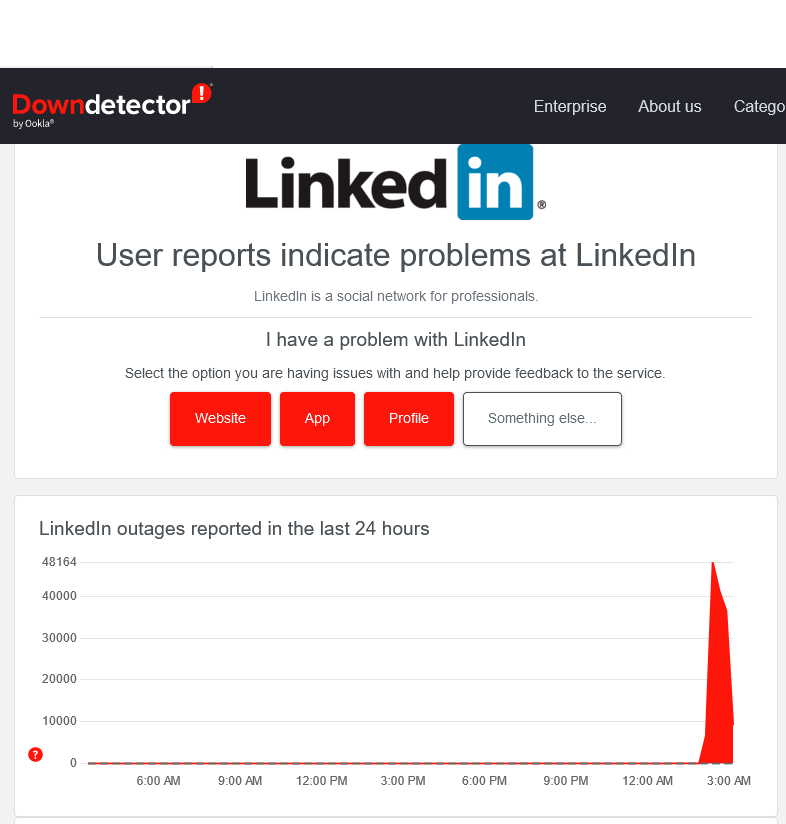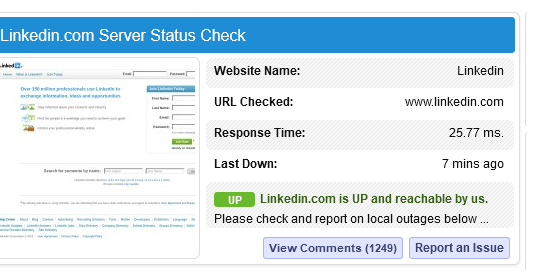LinkedIn Suffers An Outage— Thousands of Users Report the Incident
We used Microsoft's GenAI Copilot to find out the reason behind LinkedIn's outage, and what infrastructure may have been targeted in this incident.
After Meta and Instagram, LinkedIn.com, the world’s largest B2B networking site, suffered an (explicable) outage. It’s not very often that a reputable online property such as LinkedIn goes down. But today, it did, stirring the hornet’s net that has been very active since Meta’s property faced a similar fate. At the time of reporting this story, LinkedIn’s mobile app and website still showed an “Error” message on the screen.

According to Reuters, thousands of users faced difficulty in accessing their LinkedIn accounts. On 6 March, between 12 noon and 1 PM PST, downdetector.com dashboard reported 48,000 problems.
 According to a popular website monitoring tool, isitdownrightnow.com, some users were able to use the website. The server check showed it’s up and running.
According to a popular website monitoring tool, isitdownrightnow.com, some users were able to use the website. The server check showed it’s up and running.

By 2 PM PST, we were able to log into the website and access our pages.
According to a recent report, LinkedIn has 990 million users, mostly from the US, India, and China.
This is a hectic week for large organizations. Earlier this week, reports speculated that three cyber threat groups – led by Skynet, shut down Meta’s Instagram, Facebook, and Threads. Users were automatically logged out of the Meta platforms, preventing users from accessing their accounts for nearly 2 hours.
A big year in the political sense, LinkedIn’s shutdown today points to the growing threats arising from democratized cybercrime groups in 2024. These attackers are likely picking platforms that have the biggest clout in influencing conversations, using IT-focused attacks as a bargaining chip to stir anxiety and confusion.
Our analysis points to 3 possible reasons behind this incident:
Malfunction in the Web-hosting
The Internet is a complex web of content delivery systems and microsites. Even the slightest policy change by data center service providers or internet service providers can result in disconnected servers. Depending on the geography and distribution of data centers that could store LinkedIn resources, a malfunction in web hosting could be a major reason for today’s incident.
According to Microsoft’s Generative AI assistant, Copilot, LinkedIn relies on a robust IT and data management infrastructure.
We asked Copilot about the server used for LinkedIn.
The gen AI tool answered:
LinkedIn.com uses a variety of technologies for its server-side operations. Here are some key details:
Server-side Programming Language: LinkedIn uses Java as its server-side programming language.
Client-side Programming Language: JavaScript is used on the client side.
JavaScript Libraries: LinkedIn uses React for building user interfaces.
Web Hosting Provider: Microsoft, a multinational technology company headquartered in the USA, provides web hosting for LinkedIn.
Data Center Provider: Microsoft also serves as the data center provider.
SSL Certificate Authority: DigiCert is the SSL certificate authority for LinkedIn.
It’s also worth noting that LinkedIn has announced its intent to begin transferring its workloads to Azure, Microsoft’s public cloud, over a multi-year period. This move will give LinkedIn access to a wide array of hardware and software innovations, and (an) unprecedented global scale. However, this is a multi-year journey, and LinkedIn will continue to rely on and invest in its current data centers as its scale continues to grow throughout this process.

Democratized Cybercrime
Sophisticated threat groups may have chosen LinkedIn to launch a massive coordinated attack to rout business campaigns, resulting in a loss of revenue and reputation. According to Hootsuite, LinkedIn is the most trusted platform for brands. 70% of marketers rely on LinkedIn to generate a high ROI from their social media marketing investments.
This attack against a company as big as LinkedIn would have cost cybercriminals millions to execute– something that can only be sponsored by rogue nations or state-sponsored terror groups.
DDoS Attack
We can’t rule out the scope of Distributed Denial of Service (DDoS) attacks when such incidents happen within a week. However, the way LinkedIn managed to restore its website, it’s a commendable recovery against DDoS attacks.
Given the severity of the event, we asked Microsoft’s Bing CoPilot to respond to our queries:

LinkedIn is yet to release an official statement regarding today’s event. We will keep you posted on the updates from LinkedIn.

Comments are closed.